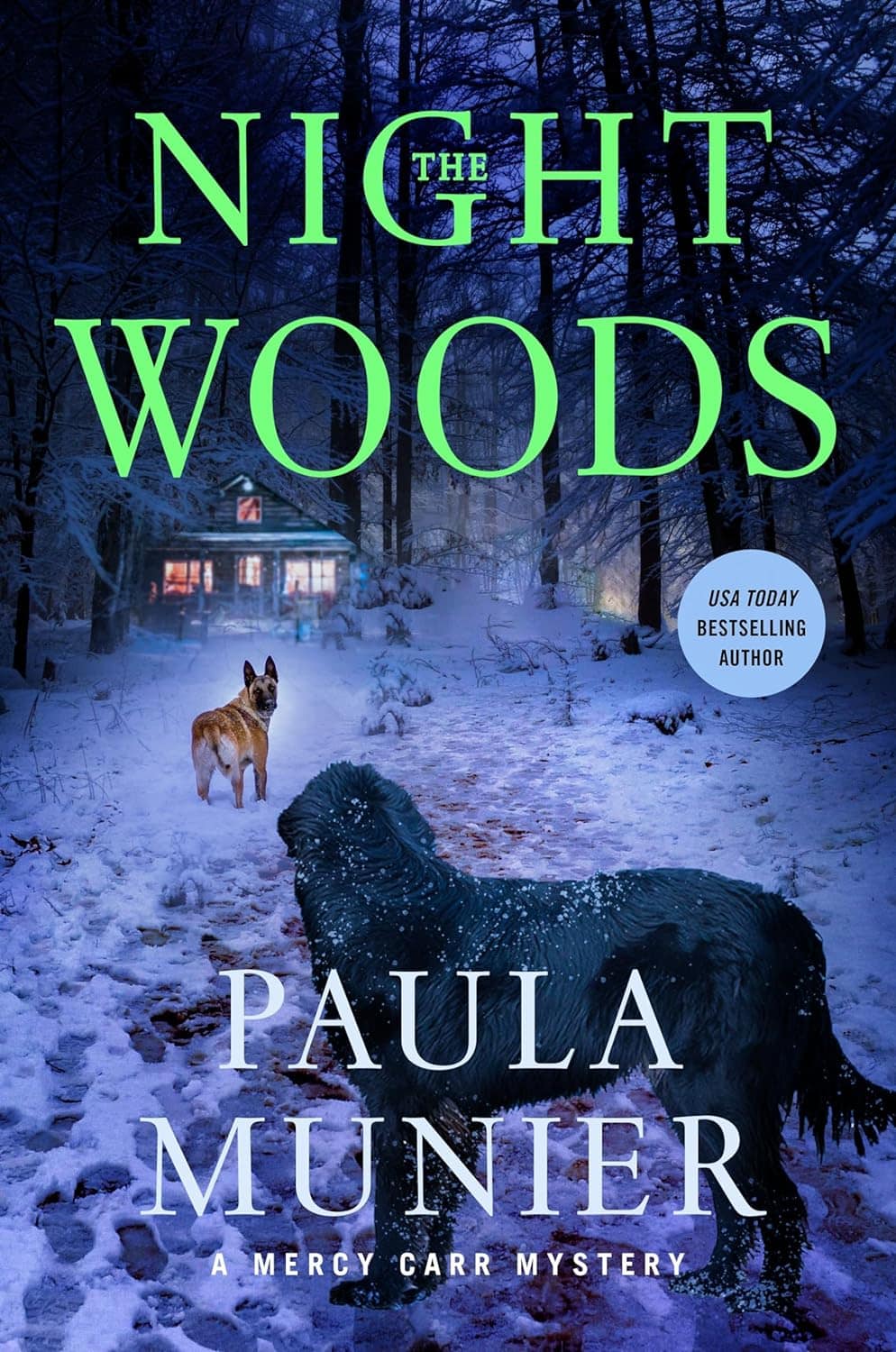The Night Woods is Paula Munier’s sixth Mercy Carr mystery, and there seems no reason why this series won’t go forever. Each of these novels stand alone, and they just seem to be getting better and better. Read one and you’ll want to read them all.
In this latest outing, Mercy is pregnant, so of course after that I am already ready to read the next book in the series (whenever it comes). I want to see this US veteran tackle motherhood. Then we shall see what stern stuff mother Mercy is made of. But in the meantime, back to The Night Woods. I have a few questions for Paula.
For so many reasons, I love the hermit Homer in your new book, but can you share with readers how this name choice is emblematic of the whole novel?
This is such an interesting question, because it gets to the heart of the creative process. Or at least mine, anyway. Beginning a story is making a series of decisions about the characters, the plot, the setting, etc.—and then living with those decisions as you work your way from Page One to The End
With The Night Woods, I started with the idea that a very bored, very pregnant Mercy would befriend an erudite hermit in the woods and that she and Elvis would hike out to his remote cabin in the woods for a weekly Scrabble game. I thought Homer was a good name for an erudite hermit.
That decision led to my giving Homer a dog named Argos—after the dog in The Odyssey. Which led to my making Homer a classics professor with a tragic backstory. Which led to his working on a new translation of The Odyssey. Which led to my embracing The Odyssey and its themes of war and homecoming and family—all themes that resonate with Mercy and Elvis, she as a former MP and he as a retired bomb-sniffing dog who’d both served in Afghanistan.
Looking back, what seemed like a randomly chosen name for the hermit—Homer—was in fact the first domino to fall in a story that ultimately became my own humble homage to The Odyssey.
So The Night Woods has an Odyssey theme while Barbara Kingsolver’s recent bestseller Demon Copperhead follows the plot of Dickens’ David Copperfield. You know the famous T.S. Eliot quote, “Good writers borrow, great writers steal”—and the two novels mentioned above are indeed both great. Tell us more about this accusation of theft. Are there only so many plots?
I love that quote, and use it often. Because it’s so true. As an agent, I can tell you that pitching a project as “a modern retelling of…” always gets an editor’s attention. In fact, I just had an editor tell me that he was only looking for modern retellings. Why? Because a modern retelling has a built-in hook, a built-in “the same, but different.” As in “just like David Copperfield, only different.” The hope is that because the original story found an audience, the modern retelling will, too.
Depending on who you ask, there are only two or three or six or seven or twenty plots. Every genre has its conventions: boy meets girl, boy loses girl, boy gets girl. The trick is to breathe new life into them. Our challenge as writers is to honor those timeless plots, but remake them in our own way.
In classic British mysteries, there’s a tradition of characters who are boorish or comically bores. In a twist, The Night Woods features another kind of malevolent boar, one with bristly fur and tusks and who walks on four feet. How did you come to add this extraordinary creature into your plot?
Mother Nature plays a key role in my stories, just as she does in New England, where I live and write. I try to spotlight one current ecological issue in every book—the problem of so-called nuisance bears, declining moose populations, endangered turtles, et cetera—and in The Night Woods the logical choice was wild boar, since there are also wild boar in The Odyssey.
The wild boar poses a terrible threat to habitat. The Eurasian boar is not native to North America, but the species is causing havoc from one coast to another. Here in New England, they are kept on private game reserves for hunting purposes, but they occasionally escape—to the detriment of virtually every other species. Once I learned that, I was off and running.
Last year in New York we had no snow, and I hated it. I adore that your novels often take place in winter. I get that Home at Night was a Halloween-themed book, but can you tell me how you chose your other books’ timeframes? Which comes first: the plot or the weather?
After twenty years in California, one of the things I love most about living in New England is the seasons. Each season here is wildly different from the rest; each presents a different landscape, a different kind of physical and emotional obstacle, a different set of themes. So, I decided to set the Mercy Carr books in successive seasons, capitalizing on the delights and the dilemmas each has to offer. Because our daily life in New England is so influenced by the weather, Mercy’s life is, too. Plot and weather go hand in hand.
All that said, I, too, love snow. With snow falling from autumn through spring here in New England, I wrote a lot of snow into the books. To the point where my editor said to me, “No more snow!” I set the next book—The Wedding Plot—in June. But I’m back to snow….
This season-by-season approach also helped me address a problem every series author must face: how quickly to age your characters. Do they age in real time, or never age at all? Setting the books in successive seasons has allowed me to age Mercy and the other characters more slowly—four times more slowly than real time.
You are a highly-sought-after literary agent and a bestselling novelist. Certainly, your agenting and selling other writers’ books to publishers must inform your own writing and plots. Can you tell us one or two ways how?
Being an agent means that I am in the trenches pitching and selling stories every day. I see what sells and what doesn’t, why certain stories get rejected while others go to auction. That knowledge reinforces what I already know but do not dare to forget: that I need to keep the reader reading and give readers what they want.
With each new book in my Mercy Carr series, I have to serve up what my readers tell me they love about Mercy and Elvis, and at the same time I must keep the series fresh by introducing new characters, new elements, new twists. In short, I need to go for broke in every single book. Authors who go for broke in every single book tend to sell, and they keep on selling. It’s a tall order for any writer, myself included. But I keep on trying.
Agents, editors, publishers, and readers all want writers who write—not just one story, but story after story after story. Because the world needs good stories, now and forever.





